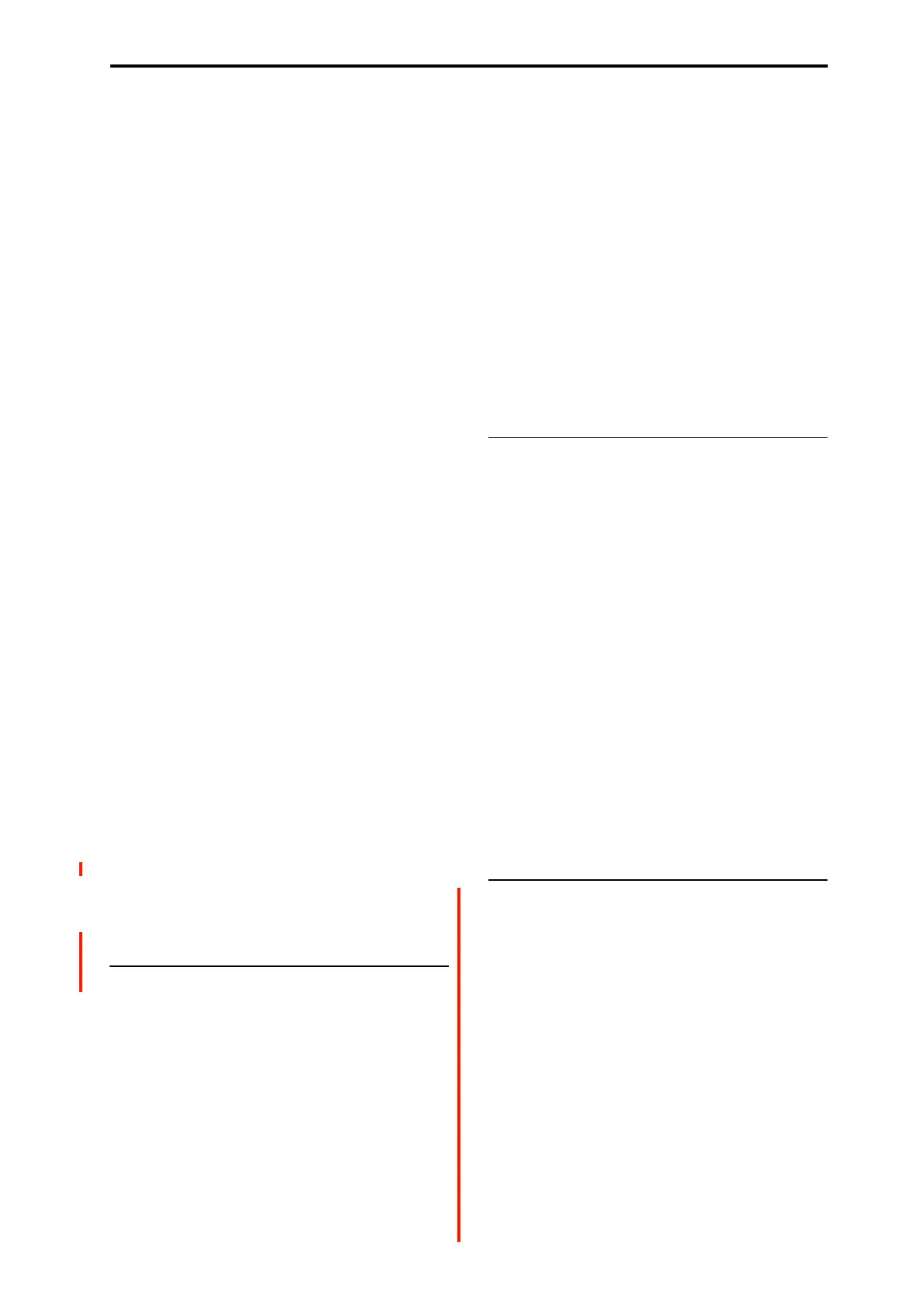SAMPLING > Recording 0–1: Recording
579
Example: Sampling a stereo source connected to
AUDIO INPUTS 1 and 2
If using the Audio Input:
Source Bus: Audio Input1/2 (0–8c)
Resample: Manual (0–8c)
Recording Level [dB]: as desired (0–1c)
Mode: Stereo (0–1d)
(→ see diagram in 0–8c: Source Bus = Audio Input1/2)
If using the L/R Bus:
Input1 Bus Select (IFX/Indiv.): L/R (0–8a)
Input1 Pan: L000 (0–8a)
Input1 Level: 127(0–8a)
Input2 Bus Select (IFX/Indiv.): L/R (0–8a)
Input2 Pan: R127 (0–8a)
Input2 Level: 127 (0–8a)
Source Bus: L/R (0–8c)
Resample: Manual (0–8c)
Recording Level [dB]: as desired (0–1c)
Mode: Stereo (0–1d)
(→ see diagram in 0–8c: Source Bus = L/R)
Example: sampling a stereo input, with internal
effects
Here, we’ll apply the internal effect 012: St.Graphic 7EQ to
a stereo source connected to AUDIO INPUTS 1 and 2, and
then sample in stereo.
Input1 Bus Select (IFX/Indiv.): IFX1 (0–8a)
Input1 Pan: L000 (0–8a)
Input1 Level: 127 (0–8a)
Input2 Bus Select (IFX/Indiv.): IFX1 (0–8a)
Input2 Pan: R127 (0–8a)
Input2 Level: 127 (0–8a)
Source Bus: L/R (0–8c)
Resample: Manual (0–8c)
IFX1: select 012: St.Graphic 7EQ (IFX– Insert FX page)
Recording Level [dB]: as desired (0–1c)
Mode: Stereo (0–1d)
(→ see diagram in 0–8c: Source Bus = L/R)
0–1e: Create Zone Preference
These settings define the initial state of the indexes that are
created when you press the Create button (0–1b, 3–1b). Each
new index will be created according to the settings you make
here, but you are free to modify the settings later.
Position [Right (to Selected Index),
Left (to Selected Index)]
Specifies whether the new index will be created at the right
or left of the selected index.
Right (to Selected Index): The new index will be created at
the right of the currently selected index.
Left (to Selected Index): The new index will be created at
the left of the currently selected index.
Zone Range [1 Key…127 Keys]
Specifies the key range of the newly created index.
1 Key: Each individual note of the keyboard will be an
index. The sample of an index will sound at its original key
when you play that note.
2 Keys–127 Keys: The sample will change pitch in semitone
steps across the specified number of keys, centered on the
original key Original Key (0–1b, 3–1b). If Constant Pitch
(3–1b) is checked, the pitch will not change.
Original Key Position [Bottom, Center, Top]
Specifies where the original key will be located in the zone
(specified by “Zone Range”) for a newly created index.
Bottom: The lowest key in the zone will be the original key.
Center: The middle key in the zone will be the original key.
Top: The top key in the zone will be the original key.
0–1f: Free Sample Memory/Locations
RAM [000.0…999.9 sec]
This shows the remaining amount of sample RAM, in both
seconds and bytes. The free RAM determines the available
sampling time, the maximum size of sample files that can be
loaded in MEDIA mode, and the maximum size of samples
during editing. The graph to the right shows the free space in
white, and the used space in blue.
Note that the amount of RAM available for user sampling
will vary depending upon both the amount of physical RAM
installed, and the size of the currently loaded EXs banks.
Multisamples [0000…3999/4000]
Samples [00000…15999/16000]
Samples in MS [00000…15999/16000]
These show the number of multisamples and samples in
RAM, as well as the number of samples which are already
placed in multisamples. The current numbers are shown on
the left, and the maximum numbers are shown on the right.
The graphs to the right show the free amounts in white, and
the used amounts in blue.
0–1g: Sampling button
SAMPLING REC
Press the button to enter sampling standby.
To begin sampling, press the SAMPLING START/STOP
button.
SAMPLING START/STOP
Press this button after pressing the SAMPLING REC button.
Next, one of the following three things will occur depending
on the “Trigger” settings.
• When “Trigger” is set to “Sampling START Button”,
pressing this button will immediately begin sampling.
• When “Trigger” is set to “Note On”, sampling begins
after you press this button and then play a key (note on)
on the keyboard.
• When “Trigger” is set to “Threshold”, sampling begins
after you press this button and the threshold level is
reached for the audio source.

